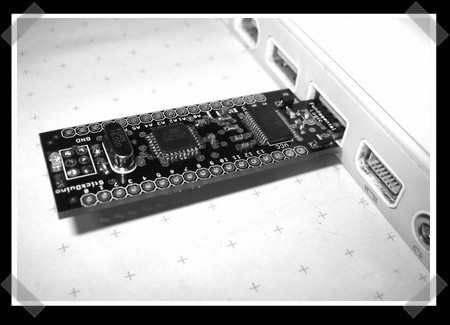
The Arduino hardware clones keep rolling in. This weeks entry into the modern dev board’s roster is the StickDuino. The board is designed to be fully hardware compatible and plugs directly into your USB port. The StickDuino uses all SMD components. The creators know that this can make assembly more difficult so they’ve space the components out, opted for larger pads, and collected some links to SMD tutorials. The board feature two more analog inputs than the Diecimila and it has a jumper so you can switch it to 3.3V. All around it looks like a great product; frankly we love anything with full board layouts.
7 thoughts on “StickDuino, USB Stick Arduino Clone”
Leave a Reply
Please be kind and respectful to help make the comments section excellent. (Comment Policy)














Nice! Keep the arduino articles coming!
Can we get a quick link on the right for the arduino articles?
Do want.
Yes. You could drop the link to Aibo Hacks, of which there is only one, and add an Arduino link.
“The StickDuino uses all SMD components.”
that big ‘ol crystal is not surface mount.
It’s worth noting that is costs just under $20USD fully assembled.
Also, no power regulator on board, so you’ll have to provide your own if you don’t want to power this from the USB or some other 5V or 3.3V source.
I second the replacement of aibo with arduino in the links. Arduino is affordable and designed for hackers, Aibo, not so much.
@ xander, 3.3/5v is quite easy to provide, I use 4xAA/AAA NiMH cells for 5v (~4.8v) and 2 Lithium AAA for 3.3volts. It is pretty simple to get ahold of 2 and 4 cell battery holders for AA and AAA sizes, with a switch no less.
For more power you could use 4 cells from a NiMH RC stick pack (usually rated 2500-3200mah compared to 2000-2600 for AA NiMH).
I prefer not to use a power regulator most of the time because of cost and conversion efficiency issues. And why use one when simple battery packs from 700mah to 3200mah are available for a reasonable price?
I agree that it isn’t so simple when you are using a different voltage, but it isn’t necessary to use a 9v battery and a voltage regulator when a plain AA/AAA pack will work just fine.
If I need a voltage regulator I can raid the bin at the local second-hand shop for a wall-wart or a cigarette-lighter converter that supplies the voltage I need. The cigarette-lighter models generally use a simple circuit with rated for use on a 7.2 volt – 16 volt battery, so you are all set for under $2.
One more thing, did anyone else notice that this guy(gal?) has been soldering directly to the display connector?
I was looking at it and noticing the crud was silver, and then realized that the connector was tinned!